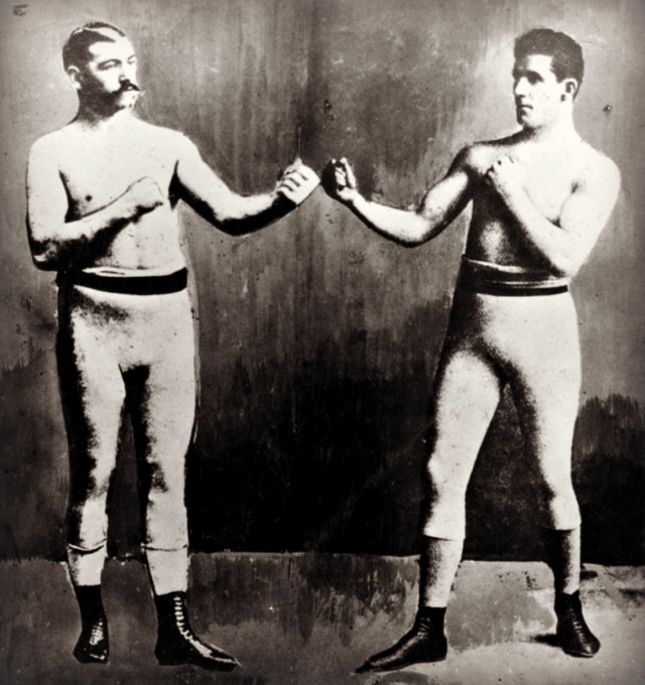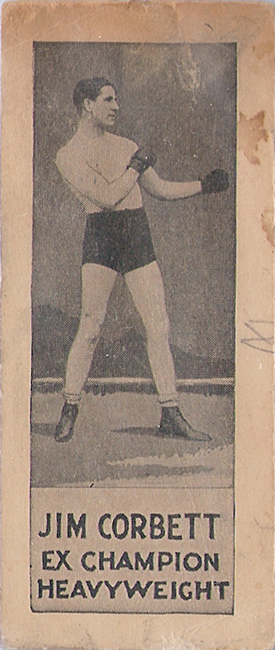
Going to college (allegedly) and working as a bank clerk doesn’t necessarily qualify someone as a ‘gentleman’. In England, for example, you’d probably have to have attended a public school as well, and have a few ancestors who were at the right hand of William the Conqueror or fought against Oliver Cromwell in the Civil War.
But if you were a professional boxer in the 1890s that sort of background—the education and the bank job—set you apart. That was why James J. Corbett was so different from most of his peers. That, and the fact that he wore his hair in a pompadour, dressed in well-cut clothes and spoke grammatically correct English, meant that he was well entitled to his famous nickname, Gentleman Jim.
Corbett was San Francisco-born but firmly of Irish stock. One of his uncles, his namesake Father James Corbett, was parish priest of Partry in Co. Mayo. In the mid-1880s he became peripherally involved in the playing out of the bloody case of the Maamtrasna massacre, in which a family of five was brutally murdered.
In 1854 Jim Corbett’s father, Patrick, had emigrated to America from Ballinrobe. Corbett himself was born in San Francisco in 1866 into a working-class Irish district south of Market Street. He certainly had a high school education and, whether or not he ever really did go to college, he was a literate and articulate man. As an 18 year old, despite his relatively poor background, his skills as a boxer meant he was admitted to membership of the oldest sporting club in the USA, the San Francisco Olympic Club. By the age of twenty he was working there as a boxing coach.
His first professional fight was an undistinguished affair against a boxer called Frank Smith, in Salt Lake City, Utah in 1886. Both boxers wore gloves, something that was true of all twenty of Corbett’s professional bouts. The fight took place under Queensberry rules, which Smith quickly transgressed. He was disqualified in the third round, gifting the Irish-American a winning start to his professional career.
During Corbett’s subsequent rise the sport of boxing assumed an air of relative respectability. It was still banned in many American states but the gradual disappearance of bare-knuckle fights which continued until one or other boxer was knocked out or threw in the towel—bouts could last up to four hours— meant that more professional promotions could now take place openly.
As Corbett rose through the ranks he would have regarded his fellow Irish-American, John L. Sullivan, with envy. Sullivan became World Heavyweight champion in 1882 and had held onto his title for a decade before he met Corbett in the ring. Sullivan, twenty-five pounds heavier than his rival, was a bruiser who specialised in overpowering anyone who stepped into the ring with him. Corbett’s approach was more cerebral and scientific. He studied his opponents, went into each fight with a game plan and used his superb fitness and manoeuverability to stay out of trouble and to wear his man down.
The only encounter between the two took place in New Orleans in 1892. In his own account of the bout Corbett described what happened after the bell went for round one.

‘From the beginning of the round Sullivan was aggressive. [He] wanted to eat me up right away. He came straight for me and I backed and backed, finally into a corner. While I was there I observed him setting himself for a right-hand swing … I sidestepped out of the corner and was back in the middle of the ring again, Sullivan hot after me. I allowed him to back me into all four corners, and he thought he was engineering all this … But I had learned what I wanted to know. He had shown his hand to me.’
| The New Orleans crowd was none too pleased at what they perceived as Corbett’s reluctance to mix it with the champion. A section of the audience began to hiss the younger fighter and call him ‘Sprinter’. Corbett kept moving until the third round, when he started swinging, and broke the champion’s nose. From that point onwards the challenger’s approach, a combination of jabs, hooks and sidesteps, appeared to bewilder the ageing Sullivan, eight years older than Corbett.
A minute and a half into the twenty-first of the scheduled twenty-five rounds, Corbett ended the fight with a vicious combination of full blooded punches which left Sullivan on the canvas. Two years later, as world champion, Corbett visited his ancestral home in Ballinrobe and donated a stained glass window to his namesake’s church in Partry. John L. Sullivan and James J.Corbett fought for the World Heavyweight title one hundred and twenty-six years ago, on this day.
|

You must be logged in to post a comment.